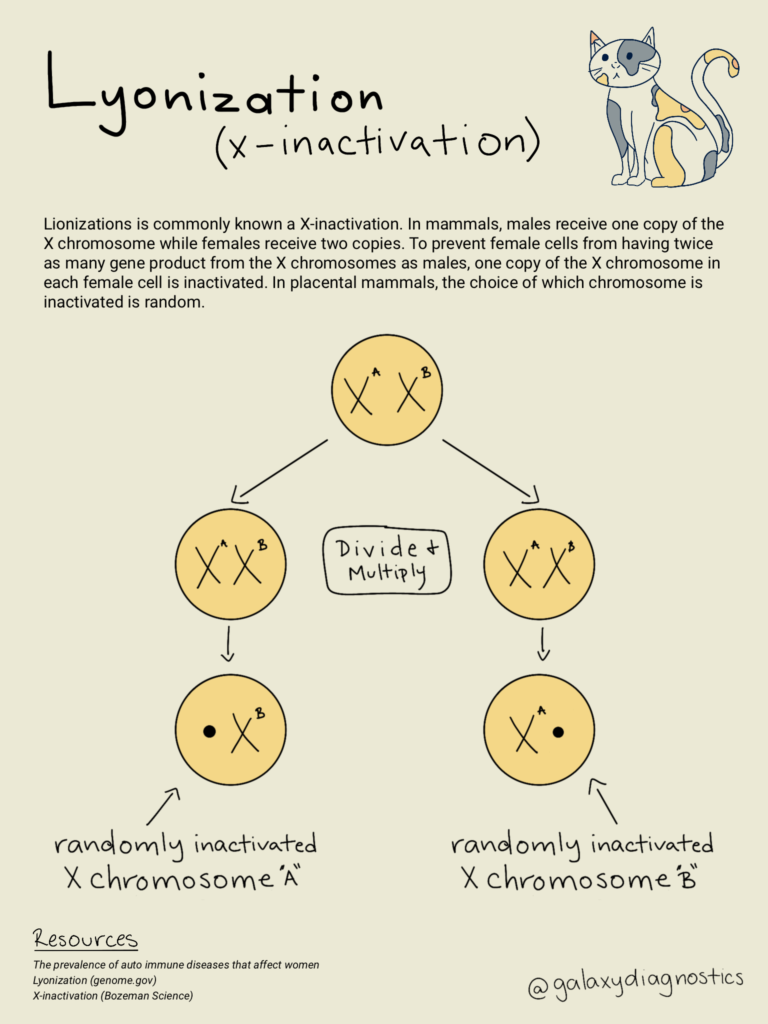Autoimmune disorders are conditions in which the immune system attacks the body. They can be sporadic and only cause complications occasionally, but most people who suffer from them experience symptoms more regularly. These disorders primarily affect women, and more is being understood about how sex, genetics, and hormones impact autoimmune disorders.

Photo via Pexels by mododeolhar
How Common Are Autoimmune Disorders?
About 1 in 25 people worldwide are affected by an autoimmune disorder. In the US, about 1 in 12 people have at least one disorder. While men often have more severe cases, women make up about 80% of autoimmune disease diagnoses. Common autoimmune disorders that affect more women than men include but are not limited to:
- Multiple sclerosis
- More commonly referred to as MS, this disease affects the central nervous system and disrupts the myelin sheath that covers and protects the nerves, resulting in interference to signals in the brain.
- Systemic lupus erythematosus (lupus)
- Lupus is a condition that causes the body to attack itself. The inflammation caused by lupus can affect the joints, skin, kidneys, and other organs.
- Rheumatoid arthritis
- This condition happens when the immune system attacks the joint lining throughout the body. This leads to joints riddled with pain and stiffness, making mobility and everyday tasks difficult.
- Psoriasis
- Psoriasis occurs when there is a rapid production of skin cells that causes a buildup. It can be characterized by patches of red, scaly, inflamed patches of skin. Psoriasis can also affect the joints.
The Why and the What
Despite the discrepancy in prevalence, identifying why women are disproportionately affected by autoimmune disease has only recently been a topic of discussion. One area of study explores the relationship sex chromosomes have with autoimmune disorders.
Why? Sex Chromosomes – Researchers believe that sex chromosomes have an impact on a person’s likelihood of developing an autoimmune disorder. Most commonly, the female sex is born with XX chromosomes (one X chromosome from each parent), and the male sex is born with XY chromosomes (an X from a female parent, and a Y from a male parent). The X chromosome is significantly larger than the Y chromosome and is estimated to have over 100 times as many genes coded with protein instructions.
According to a 2020 study, X chromosomes have a larger number of immune-related and immune-regulatory genes. People born with two X chromosomes tend to have a stronger immune system and can more efficiently fight off viruses. However, a strong and swift immune system can be a double-edged sword. Having two X chromosomes increases the likelihood of mutation, leading to a greater risk of developing an autoimmune disease.
 The way cells reduce the risk of genetic mutations is through x-inactivation. This process occurs to purposefully, yet randomly, silence unnecessary X chromosomes. One of the best examples of this is present in calico cats.
The way cells reduce the risk of genetic mutations is through x-inactivation. This process occurs to purposefully, yet randomly, silence unnecessary X chromosomes. One of the best examples of this is present in calico cats.
The color of a cat’s fur is determined by genes in the X chromosome. Therefore, calico cats are almost always female. A female cat may have an X chromosome coded with a gene for black fur, and the other is coded with a gene for orange fur. As the embryo develop, and stems cells divide and multiply, one of the X chromosomes in that cell is deactivated. This could be either the black fur gene, or the orange fur gene. There is no way to tell which chromosome was deactivated until the kitten is born. That’s when you can see the calico or tortoiseshell pattern.
What? Hormones and Pregnancy – Research suggests that hormonal changes play a role in triggering the development of autoimmune disorders. Puberty, pregnancy, and menopause all affect hormone levels greatly. The female reproductive life cycle best demonstrates the relationship between hormones and multiple sclerosis.
Dr. Rhonda Voskuhl started studying the sex discrepancy between men and women with autoimmune diseases in the 90s. She uses MS as a model for her research. Women are more likely to develop multiple sclerosis after puberty. Studies show an increased number of cases in women post-puberty that is not reflected in men post-puberty.
During pregnancy, there seems to be a decrease in the symptoms and severity of MS due to the estrogen hormone estriol produced in the placenta. This hormone has anti-inflammatory properties, and pregnant people with MS experience a 70% reduction in relapses.
Clinical observations show that almost 50% of postmenopausal MS patients noted worsening symptoms. Postmenopausal patients on hormonal treatment saw an improvement in their symptoms.
So much can be said about the connection between autoimmune diseases and pregnancy without considering hormones. One theory explores what it means to keep a fetus alive. A fetus is a foreign entity with foreign antigens. The immune system seems to adapt so as not to reject the fetus. This adaptation may trigger the onset of an autoimmune disease.
What is the role of infectious disease?
Infectious disease can trigger immune dysregulation connected to autoimmune disorders. Recent studies suggest that the Epstein-Barr virus infections may be implicated with the onset of multiple sclerosis. Flea and tick-borne diseases can mirror autoimmune disorders, like MS or rheumatoid arthritis, if left untreated. We recently wrote about how COVID-19, Lyme disease, bartonellosis and other conditions are linked to endothelial cell dysregulation.
People diagnosed with long-term Lyme disease complications characterized as either “post-Lyme disease syndrome” or “chronic Lyme disease” are more than twice as likely to be female.
As people with autoimmune symptoms try to understand the cause of their immune dysregulation, their physician may consider tick-borne disease testing. Find out more about the advanced technologies Galaxy Diagnostics uses to detect low-abundance infections.
Conclusion
Autoimmune diseases are a complex interplay of genetics, hormones, pathogen exposure and other biological and environmental factors. For a variety of reasons, the study of the role of sex chromosomes in chronic disease has lagged despite the clear difference in frequency of conditions such as autoimmune diseases. We look forward to research that continues to clarify the underlying causes and potential cures for chronic disease.
References
Doctrow, B. (2022, February 1). Study suggests Epstein-Barr virus may cause multiple sclerosis. NIH Research Matters. https://www.nih.gov/news-events/nih-research-matters/study-suggests-epstein-barr-virus-may-cause-multiple-sclerosis
Andersen, P. [Bozeman Science]. (2012, April 26). X inactivation [Video]. YouTube. https://www.youtube.com/watch?v=Y9vXhmI5FXM
Unachukwu, I. (2021, January 11). Why are women and people with cycles underrepresented in health research? https://helloclue.com/articles/culture/why-are-women-and-people-with-cycles-underrepresented-in-health-research
Sohn, E. (2021, July 14). Why autoimmunity is most common in women. Nature, 595, S51-S53. 10.1038/d41586-021-01836-9 https://www.nature.com/articles/d41586-021-01836-9
Golden, L. C., & Voskuhl, R. (2017). The importance of studying sex differences in disease: The example of multiple sclerosis. Journal of Neuroscience Research, 95(1-2), 633-643. 10.1002/jnr.23955 https://onlinelibrary.wiley.com/doi/10.1002/jnr.23955
Kraft, S. (2021, September 21). 5 common autoimmune diseases that affect women. https://www.amitahealth.org/blog-articles/womens-health/5-common-autoimmune-diseases-that-affect-women
Angum, F., et al. (2020). The prevalence of autoimmune disorders in women: A narrative review. Cureus, 12(5), e8094. 10.7759/cureus.8094 https://www.ncbi.nlm.nih.gov/pmc/articles/PMC7292717/
Dillner, L. (1999, March 2). Who gets sicker, men or women? The Guardian. https://www.theguardian.com/lifeandstyle/1999/mar/02/healthandwellbeing.health5
Gupta, S. (2016). Why sickness and health can look different for women than men. https://www.hopkinsmedicine.org/research/advancements-in-research/fundamentals/in-depth/why-sickness-and-health-can-look-different-for-women-than-men
Lucke, J., et al. (2007). Trends in women’s risk factors and chronic conditions: Findings from the Australian Longitudinal Study on Women’s Health. Women’s Health, 3(4), 423-432. 10.2217/17455057.3.4.423 https://journals.sagepub.com/doi/pdf/10.2217/17455057.3.4.423
DiGiacomo, M., et al. (2015). Developing a gender-based approach to chronic conditions and women’s health: A qualitative investigation of communitydwelling women and service provider perspectives. BMC Women’s Health, 15, 105. 10.1186/s12905-015-0264-4 https://bmcwomenshealth.biomedcentral.com/track/pdf/10.1186/s12905-015-0264-4.pdf
Pan American Health Organization. (2011, February 28). Women and men face different chronic disease risks. https://www3.paho.org/hq/index.php?option=com_content&view=article&id=7732:2011-women-men-face-different-chronic-disease-risks&Itemid=4327&lang=en
National Institute of Arthritis and Musculoskeletal and Skin Diseases. (2019). Osteoporosis overview. https://www.bones.nih.gov/health-info/bone/osteoporosis/overview
National Stem Cell Foundation. (2022). Autoimmune disease. https://nationalstemcellfoundation.org/glossary/autoimmune-disease/
Reardon, S. (2016, June 22). Infections reveal inequality between the sexes. Nature, 534, 447. https://www.scientificamerican.com/article/infections-reveal-inequality-between-the-sexes/
Ahn, J. Y. (2008). Females (XX) carry twice as many X-linked genes on their sex chromosomes as males (XY). How do cells control gene expression to manage this potentially lethal dosage problem? Nature Education, 1(1), 24. https://www.nature.com/scitable/topicpage/x-chromosome-x-inactivation-323/
Bjornevik, K., et al. (2022). Longitudinal analysis reveals high prevalence of Epstein-Barr virus associated with multiple sclerosis. Science, 375(6578), 296-301. 10.1126/science.abj8222 https://www.science.org/doi/10.1126/science.abj8222
Wormser, G. P., & Shapiro, E. D. (2009). Implications of gender in chronic Lyme disease. Journal of Women’s Health, 18(6), 831-834. 10.1089/jwh.2008.1193 https://www.ncbi.nlm.nih.gov/pmc/articles/PMC2913779/#:~:text=Results,3.34%2C%20p%20%3C%200.0001)


